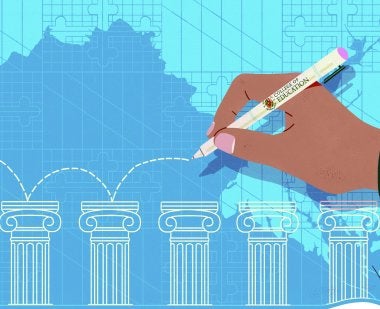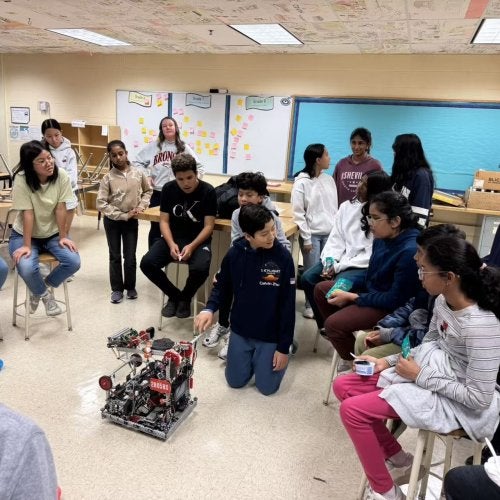
The state of Maryland’s landmark bill to reform education in public schools has the College of Education’s fingerprints all over it.
Approved by the General Assembly in 2021, the $3.9 billion “Blueprint for Maryland’s Future” will invest in teachers, students and families statewide over the course of 10 years, hiring an additional 15,000 educators and raising the minimum teaching salary to $60,000.
The plan also calls for major investments in equity. Funding will increase for English-language learners, special education students and schools in high-poverty areas. Access to free, publicly funded pre-K will expand, and one-third of all Maryland schools will become community schools—providing students and families with academic support, nutrition services and health care.
The plan is based on the work of a state panel known as the Kirwan Commission (named for former University System of Maryland Chancellor and former UMD President William “Brit” Kirwan). At the time it was formed, Maryland students were underperforming on a variety of learning outcomes. Statewide, National Assessment of Educational Progress scores had fallen to about the national average, for example, and less than a third of Maryland’s high school graduates were considered “college and career ready.” Plus, Maryland was seeing significant inequities in scores based on income, race, and disability.
From the commission’s start in 2016, the College of Education has helped shape its recommendations. Senior Vice President and Provost Jennifer King Rice (then the college’s dean) served as an expert on several workgroups—bringing cutting-edge research and evidence-based policy recommendations to the table.
Today, as the policies outlined in the Blueprint shift into action, faculty and staff continue to take a leading role in transforming education for the nearly 900,000 students enrolled in Maryland public schools.
Maryland Professional Development Schools 2025 Project
“We know from research that teachers are the single most important school-based factor in creating educational opportunities for all students,” says Provost Rice. “However, as a society, we’ve very much under invested in teachers.”
The average teaching salary in Maryland is 25% below that of professions with comparable education requirements and nearly half of all Maryland teachers in their second year aren’t returning for a third.
The second pillar of the Blueprint addresses this issue head on, calling for increased salaries and better professional development. “If we want excellent education,” explains Rice, “we need to support excellent and diverse teachers. As a college of education, that’s core to what we do.”
As such, the college launched the Maryland Professional Development Schools 2025 Project—a collaborative effort between UMD, Montgomery County Public Schools (MCPS), Prince George’s County Public Schools (PGCPS), Montgomery County Education Association and Prince George’s County Education Association.
Funded through the Teacher Collaborative Grant Program, the project creates a “teacher career ladder” as called for in the Blueprint. The career ladder outlines clear pathways for advancement and professional development by creating new roles for practicing teachers in MCPS and PGCPS. The project also reimagines the student internship experience and creates a Supervising Mentor Teacher Academy.
Lawrence Clark, associate dean in the Office of Undergraduate Studies and mathematics education faculty, is the principal investigator (PI) for the project, and Megan Madigan Peercy, associate dean for undergraduate and graduate studies, is the co-PI.
“Policymakers inside and outside the state are really watching Maryland around this,” Clark says. “So it’s quite exciting for the College of Education to be in the position to influence and support the decision-making process of the two largest school districts in the state that could potentially influence how teacher career ladders are structured throughout the entire country.”
Teaching English to Speakers of Other Languages (TESOL)
The Blueprint also recognizes the need to provide more support for vulnerable students, establishing a Workgroup on English Learners in Public Schools to accelerate the academic achievement of the state’s 98,000 multilingual students.
Drew Fagan, associate clinical professor and TESOL program coordinator, was invited by the State Superintendent’s Office to serve on this workgroup as the English language learner advocate. His role involves amending school and educator certification requirements to ensure that English learners have a more equitable experience, one that allows them to achieve both academic success and language proficiency.
Fagan is also the 2022-2023 Maryland TESOL Association President and has worked extensively throughout the state creating teacher education and administrator degree programs that help all educators learn how to address English learner needs across the K-12 curriculum.
According to Fagan, “Maryland has the opportunity right now to be at the pinnacle of addressing the needs of multilingual learners.” MSDE is now making amendments to educator preparation and certification programs and promoting the expansion of dual certification programs in Maryland’s colleges and universities.
Early Childhood Certification and Pre-K Curriculum
With the expansion of early childhood and Pre-K programs, the state will need an influx of certified teachers to cover the additional classrooms. Fortunately, the College of Education is building a pipeline of highly qualified, certified educators.
“Our graduates are certainly well-prepared to step into these positions,” says Christy Tirrell-Corbin, director of the Early Childhood/Early Childhood Special Education Program, explaining that the unique, dual-certification program at UMD prepares graduates for both early childhood general education (Pre-K-3rd grade) and early childhood special education (birth-3rd grade).
Additionally, Tirrell-Corbin developed a Pre-K curriculum that’s currently used in over 200 classrooms statewide and aligned with Maryland’s early learning and development standards. She also serves on several groups related to the Blueprint’s early childhood pillar, including the Early Childhood Research Advisory Committee and the State Interagency Coordinating Council.
Accountability and Implementation
To ensure the successful implementation of the Blueprint’s many goals, lawmakers created an independent unit of government known as the Accountability and Implementation Board (AIB).
This seven-member board, in cooperation with four advisory committees, is responsible for monitoring the use of Blueprint funds allocated to state and local government agencies. It’s also charged with evaluating and reporting on numerous outcomes associated with Blueprint initiatives.
The college has both a faculty member and a doctoral student serving on the AIB: Laura Stapleton, professor and chair of the Department of Human Development and Quantitative Methodology, and Joe Manko, program officer at the Abell Foundation, who is writing his dissertation on community schools.
Catalyzing Transformative Change
Much of the Blueprint’s early work involved looking at the world’s best systems and understanding what they were doing that Maryland wasn’t. Now however, Rice believes the state is on the other side:
“We’ve studied, we’ve brought research to the table—excellent, cutting edge research that involves our faculty. And as a state we’re implementing practices and policies that have the potential to completely transform educational systems, both in terms of their excellence, and their equitable approaches.”


